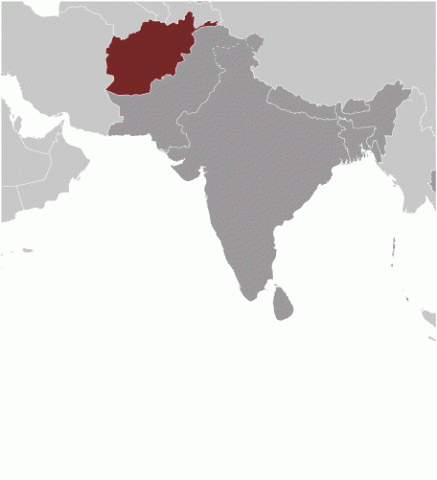Child Labor and Forced Labor Reports
Afghanistan


No Advancement
In 2022, Afghanistan made no advancement in efforts to eliminate the worst forms of child labor. The humanitarian crisis following the Taliban takeover in August 2021 resulted in an increase in the prevalence of child labor, including its worst forms, and exacerbated existing child labor risks for girls. In addition, the COVID-19 pandemic, drought conditions, and worsening economic conditions further exacerbated child labor, child marriage, and child trafficking in the country. During the reporting period, the Taliban actively recruited and used children as part of their security forces. Furthermore, authorities considered some child trafficking victims, especially those engaged in bacha bazi or in armed conflict, as criminals, housing them in juvenile detention centers and subjecting them to torture and other forms of ill treatment rather than referring them to victim support services. Children in Afghanistan are subjected to the worst forms of child labor, including in armed conflict, forced labor in the production of bricks and carpets, and commercial sexual exploitation. The government lacks a mechanism to impose penalties for child labor violations and sufficient programs to address situations of child labor or prevent its occurrence. In addition, Afghan law does not sufficiently criminalize forced labor, debt bondage, or the commercial sexual exploitation of girls.
Table 1 provides key indicators on children’s work and education in Afghanistan.
| Children | Age | Percent |
| Working (% and population) | 5 to 14 | 12.0 (1,206,134) |
| Attending School (%) | 5 to 14 | 36.4 |
| Combining Work and School (%) | 7 to 14 | 6.5 |
| Primary Completion Rate (%) | 84.3 |
Source for primary completion rate: Data from 2019, published by UNESCO Institute for Statistics, 2023. (1)
Source for all other data: International Labor Organization's analysis of statistics from Income, Expenditure and Labour Force Survey (IE&L), 2019–2020. (2)
Based on a review of available information, Table 2 provides an overview of children's work by sector and activity.
| Sector/Industry | Activity |
|---|---|
| Agriculture | Farming, including harvesting poppies (3-6) |
| Herding (3-5) | |
| Industry | Carpet weaving† (3,5-7) |
| Construction, including gravelling, paving, and painting (3-7) | |
| Coal, gold, and salt mining† (5,6) | |
| Brickmaking (3-9) | |
| Working in metal workshops, including in the production of doors, windows, and water tanks (4-6) | |
| Working as tinsmiths and welders† (4,7) | |
| Services | Domestic work (6,10,11) |
| Transporting water and goods, including across international borders (6,12) | |
| Street work, including peddling, vending, shoe shining, carrying goods, and begging (4-6) | |
| Collecting garbage† (4-6) | |
| Washing cars (4,5,7) | |
| Selling goods in stores (4,5,7) | |
| Collecting and selling firewood (4,13) | |
| Repairing automobiles (4,14) | |
| Tailoring in garment workshops (4,6,9) | |
| Pushing loads on a wheelbarrow (krachiwani) (4,7) | |
| Working as waiters in restaurants (4,5,7,15) | |
| Categorical Worst Forms of Child Labor‡ | Forced domestic work (5,6,10,16) |
| Commercial sexual exploitation (4-6,16,17) | |
| Forced labor in begging and the production of bricks and carpets, and for use as assistant truck drivers (15-19) | |
| Forced recruitment of children by non-state armed groups for use in armed conflict, including for terrorist activities and suicide bombings (5,16,20-22) | |
| Recruitment of children by state armed groups for use in armed conflict (6,16,20,23-25) | |
| Use in illicit activities, including in pickpocketing and in the production and trafficking of drugs (3-6,15-17,19) | |
| Weapons trafficking (5,16) |
† Determined by national law or regulation as hazardous and, as such, relevant to Article 3(d) of ILO C. 182.
‡ Child labor understood as the worst forms of child labor per se under Article 3(a)–(c) of ILO C. 182.
The humanitarian crisis following the Taliban takeover in August 2021 resulted in an increase in the prevalence of child labor, including its worst forms. (5,6,26-28) In addition, the COVID-19 pandemic, drought conditions, and worsening economic conditions further exacerbated child labor, child marriage, and child trafficking in the country. (5,6,16,23,26,29,30) Of all the sectors in which Afghan children work, carpet weaving is the sector with the largest number of child laborers, particularly girls between the ages of 11 and 15. (5,31) Many of these children suffer respiratory ailments. (28,32)
Children in Afghanistan are recruited and used as child soldiers. (6,16,24) According to the UN, the Taliban has dramatically increased the number of child soldiers in their ranks. (6) Dire economic conditions have made children more vulnerable to recruitment. The Taliban usually recruits boys between the ages of 14 and 17, and 97 percent of these become part of the Taliban's security forces. (6,16,23,25) In 2021, the Haqqani Network, Gulbuddin Hekmatyar’s Hizb-I Islami, and the Islamic State of Iraq and the Khorasan Province all recruited child soldiers in Afghanistan. However, research was unable to confirm if this practice continued in 2022. (16,33) Additionally, in recent years, low rates of birth registration and the falsification of identity documents contributed to the prevalence of child soldiers by making it difficult to determine a recruit’s age. (34) Observers reported that some officials accepted bribes to produce false identity documents indicating that the recipient boys were older than age 18. (17,34)
Boys in Afghanistan continued to be subjected to commercial sexual exploitation through the practice of bacha bazi, which typically entails keeping a male or transgender child for the purpose of sexual gratification. (5,6,16) Some boys were sold into the practice by their families or abducted from the street, including by police officers. (16,35) Children subjected to bacha bazi often become further victimized by the threat of violence when returning to their families, necessitating the placement of these child victims in rehabilitation centers. (5) The suspension of international aid after August 2021 significantly impacted bacha bazi victims' access to rehabilitation services. (6,26,36) According to media and NGO reports, many of these cases went unreported or were referred to traditional mediation, which often allowed perpetrators to re-offend. Cases were further under-reported because the stigma associated with these crimes prevented the vast majority of child victims from bringing cases forward to law enforcement or seeking care, especially when the alleged perpetrators were members of the police force. (6,37)
Girls from impoverished families are forced into marriage with adult men in order for the girls' families to obtain dowries. These girls are often subsequently forced into carpet weaving and required to provide their earnings to their husbands. (5,6,16,26,38,39) Girls are also sold to men in India, Iran, and Pakistan and subsequently exploited sexually or in domestic servitude. (16) Meanwhile, girls from China, Iran, Pakistan, the Philippines, and Tajikistan are sometimes trafficked to Afghanistan for the purpose of commercial sexual exploitation. (16,40) Most human trafficking victims in Afghanistan are children, some of whom are forced into brick production or the production of illegal drugs to settle family debts. (5,16,22) Boys, especially those traveling unaccompanied, are particularly vulnerable to human trafficking, including for work in agriculture and construction. (41,42) Children's families may pay intermediaries to send children for labor abroad, where they are subsequently subjected to labor and sex trafficking in Iran, Pakistan, and parts of Europe. (43)
During the reporting period, and due to the effects of poverty and on-going military conflict, roughly half of Afghanistan's children did not attend school; as many as 1.9 million children either engaged in or were subjected to work. Moreover, after August 2021, school-age girls were not allowed to attend classes beyond the sixth grade in most provinces. (5,6,30,44) During the reporting period, the Taliban further banned Afghan girls and women from attending university. (6,45) The requirement for women to be escorted by male relatives (mahram) continues not only to impact women and girls’ freedom of movement but also inhibits their access to education. (6,46) In some cases, girls faced deliberate militant attacks against their community and girls' schools, limiting their access to education. (47,48) Additional barriers to education for children included displacement of populations due to conflict, the use of schools as military bases, living long distances from schools, school-related fees, lack of security, lack of female teachers in girls' schools, and the lack of identity documentation. (6,19,23,48-50)
Afghanistan has ratified all key international conventions concerning child labor (Table 3).
| Convention | Ratification |
| ILO C. 138, Minimum Age | ✓ |
| ILO C. 182, Worst Forms of Child Labor | ✓ |
| UN CRC | ✓ |
| UN CRC Optional Protocol on Armed Conflict | ✓ |
| UN CRC Optional Protocol on the Sale of Children, Child Prostitution and Child Pornography | ✓ |
| Palermo Protocol on Trafficking in Persons | ✓ |
Afghanistan has established laws and regulations related to child labor (Table 4). However, gaps exist in Afghanistan’s legal framework to adequately protect children from the worst forms of child labor, including the lack of criminal prohibitions against the commercial sexual exploitation of children.
| Standard | Meets International Standards | Age | Legislation |
|---|---|---|---|
| Minimum Age for Work | No | 18 | Article 13 of the Labor Law (51) |
| Minimum Age for Hazardous Work | Yes | 18 | Articles 13 and 120 of the Labor Law; Article 613 of the Penal Code; Article 63 of the Law on Protection of Child Rights (51-53) |
| Identification of Hazardous Occupations or Activities Prohibited for Children | Yes | List of Prohibited Jobs for Child Laborers; Article 613 of the Penal Code (52,54) | |
| Prohibition of Forced Labor | No | Article 4 of the Labor Law; Articles 510–512 of the Penal Code; Article 37 of the Law on the Elimination of Violence Against Women (51,52,55) | |
| Prohibition of Child Trafficking | Yes | Articles 510–512 of the Penal Code (52) | |
| Prohibition of Commercial Sexual Exploitation of Children | No | Article 18.2 of the Law on Elimination of Violence Against Women; Articles 510–512, 650, and 652–667 of the Penal Code (52,55) | |
| Prohibition of Using Children in Illicit Activities | Yes | List of Prohibited Jobs for Child Laborers; Articles 1, 7, and 23 of the Counter Narcotics Law (54,56) | |
| Minimum Age for Voluntary State Military Recruitment | Yes | 18 | Articles 605–608 of the Penal Code (52) |
| Prohibition of Compulsory Recruitment of Children by (State) Military | N/A* | ||
| Prohibition of Military Recruitment by Non-state Armed Groups | Yes | Articles 510–512 of the Penal Code (52) | |
| Compulsory Education Age | Yes | 15‡ | Article 17 of the Education Law; Article 609 of the Penal Code (52,57) |
| Free Public Education | Yes | Article 17 of the Education Law (57) |
* Country has no conscription (58)
‡ Age calculated based on available information (59)
The Taliban have not made a clear pronouncement on whether the group would follow modified versions of either Afghanistan’s 1964 or 2004 constitution until it produces a new constitution, making it unclear the degree to which prior elements of the legal system remain in effect. Simultaneously, the Taliban have conveyed that prior laws remain in effect unless they violate the Taliban interpretation of sharia, as determined by Taliban courts. (60)
The Afghan Labor Law’s minimum age provision prohibits those who have not completed age 18 from being “recruited as a worker.” (51) However, the law defines “worker” as a person who is “recruited based on a definite contract,” meaning that the minimum age provision does not apply to those in informal employment. Afghan law does not sufficiently criminalize practices similar to slavery, including debt bondage. (51,52) The Penal Code criminalizes the use of male or transgender children in bacha bazi, criminalizes forcing children to dance, and criminalizes the forced use of girls in prostitution. However, the legal framework does not criminalize the use of boys or non-forced use of girls in prostitution, and it does not criminalize the use of children in pornographic performances other than dancing.(52,53,55)
Children in Afghanistan are required to attend school only up to age 15. This standard makes children between the ages of 15 and 17 vulnerable to child labor, as they are not required to attend school but are not legally permitted to work without restriction on hours and times of work. (51,52,57)
Afghanistan has established institutional mechanisms for the enforcement of laws and regulations on child labor (Table 5). However, gaps exist within the operations of enforcement agencies that may hinder adequate enforcement of their child labor laws.
| Organization/Agency | Role & Activities |
|---|---|
| Child Protection Action Network (CPAN) | Operates as a coalition of agencies, NGOs, and community and religious leaders. Receives complaints of child labor, investigates such cases, refers victims to NGO and government shelters that provide social services, provides case management services, and issues warnings or refers criminal cases to the Attorney General's Office (AGO). (19,61) Not all provinces have a CPAN chapter. The capacity of CPAN chapters is not uniform or based on need, and the type of intervention depends on members of a particular CPAN chapter and resources available. (15) In addition, a person wishing to file a complaint to the CPAN must specify in writing the precise legal statute for the labor violation, making it nearly impossible for most citizens to report labor law offenses. (61) Limited training and resources also hinder prompt government response to complaints about child labor. (19) Research was unable to determine whether the networks remained active during the reporting period. |
| Ministry of Labor and Social Affairs (MoLSA) | Responds to complaints of child labor, child trafficking, and child sexual exploitation; refers cases to the AGO and NGO shelters; and operates a shelter for human trafficking victims in Kabul. (15) Research was unable to determine whether the Kabul shelter remained in operation. |
| Ministry of Interior | Enforces laws related to child trafficking, the use of children in illicit activities, and child sexual exploitation. (15) Research was unable to determine enforcement activities undertaken during the reporting period. |
The extent to which relevant agencies are carrying out the enforcement activities mandated by the pre-August 15, 2021, government—or whether these agencies continue to exist at all—is unknown. (6)
Labor Law Enforcement
In 2022, research did not find information on whether labor law enforcement agencies in Afghanistan took actions to address child labor. (5)
| Overview of Labor Law Enforcement | 2021 | 2022 |
|---|---|---|
| Labor Inspectorate Funding | Unknown (5) | Unknown (6) |
| Number of Labor Inspectors | Unknown (5) | Unknown (6) |
| Mechanism to Assess Civil Penalties | No (62) | No (6) |
| Training for Labor Inspectors Provided | No (5) | Unknown (6) |
| Number of Labor Inspections Conducted at Worksite | Unknown (5) | Unknown (6) |
| Number of Child Labor Violations Found | Unknown (5) | Unknown (6) |
| Number of Child Labor Violations for Which Penalties Were Imposed | Unknown (5) | Unknown (6) |
| Number of Child Labor Penalties Imposed that Were Collected | Unknown (5) | Unknown (6) |
| Routine Inspections Conducted | Unknown (5) | Unknown (6) |
| Routine Inspections Targeted | Unknown (5) | Unknown (6) |
| Unannounced Inspections Permitted | No (62) | Unknown (6) |
| Unannounced Inspections Conducted | Unknown (5) | Unknown (6) |
| Complaint Mechanism Exists | Unknown (5) | Unknown (6) |
| Reciprocal Referral Mechanism Exists Between Labor Authorities and Social Services | No (5) | No (6) |
In 2022, information about the number of labor inspectors was unavailable. Before the takeover by the Taliban, government officials, NGOs, and UNICEF acknowledged that the number of labor inspectors was insufficient; this likely remains the case. (19) Moreover, sources indicate that labor inspections took place only in the capital, Kabul, prior to the Taliban takeover. It is unclear whether inspections continued after the Taliban takeover in August 2021; the international community did not supply support to labor inspectors after that time. (6,19,30) Although Afghanistan's labor code designates the Ministry of Labor and Social Affairs (MoLSA) as the entity with labor law enforcement authority, before mid-2021, the Ministry lacked implementing regulations and labor law enforcement funding, leaving inspectors with no mechanism to assess penalties and without offices equipped with modern technologies and means of transportation, limiting their ability to carry out inspections. (48)
Criminal Law Enforcement
In 2022, research did not find information on whether criminal law enforcement agencies in Afghanistan took actions to address child labor.
| Overview of Criminal Law Enforcement | 2021 | 2022 |
|---|---|---|
| Training for Criminal Investigators Provided | Unknown (5) | Unknown (6) |
| Number of Investigations | Unknown (5) | Unknown (6) |
| Number of Prosecutions Initiated | Unknown (5) | Unknown (6) |
| Number of Convictions | Unknown (5) | Unknown (6) |
| Imposed Penalties for Violations Related to the Worst Forms of Child Labor | Unknown (5) | Unknown (6) |
| Reciprocal Referral Mechanism Exists Between Criminal Authorities and Social Services | No (5) | No (6) |
After August 2021, the United Nations confirmed the continued presence of unknown numbers of children detained without regard for age with adults in prisons and juvenile rehabilitation centers. Although reports confirm the Taliban has detained and punished children found engaged in child labor, research was unable to verify the conditions of these detentions and the scope of punitive measures imposed. (6,23)
Prior to the Taliban takeover, child victims of human trafficking were routinely prosecuted and convicted of unlawful acts that traffickers compelled them to commit—and this practice is likely to have continued during the reporting period. (6,16,17) Male victims of child trafficking, especially those engaged in bacha bazi or in armed conflict, were sometimes referred to juvenile detention or rehabilitation facilities on criminal charges, instead of being referred to appropriate victim support services. (17,19,21,63) Under the Ghani administration, the government arrested, detained, and prosecuted for terrorism-related crimes children younger than age 12 who had been forcibly recruited by non-state armed groups. Furthermore, authorities housed some child trafficking victims in juvenile detention centers, sometimes for several years. (49) Such children were considered criminals even after being transferred to rehabilitation centers. (17,35) In past years, the UN reported that some of these children were subjected to torture and ill treatment. (63,64)
In 2022, research was unable to determine whether the Taliban carried out criminal investigations in alleged instances of human trafficking. In addition, security agencies and the Ministry of Justice did not have a reciprocal referral mechanism to ensure that child victims of human trafficking and other forms of child labor receive social services. (6,15,19)
The Taliban has said that the Ministry of Interior’s anti-trafficking in persons offices have been inoperable since the 2021 takeover, and that all computer systems, data, and staff in those offices are gone. These offices have yet to be restored as of the end of the reporting period. (5,6) Due to assistance restrictions, the international community has been able to provide only limited resources to support child trafficking victims. (6,30)
Afghanistan has an established mechanism to coordinate its efforts to address child labor (Table 8). However, gaps exist that hinder the effective coordination of efforts to address child labor, including lack of utilization of previously established coordinating bodies.
| Coordinating Body | Role & Activities |
|---|---|
| National Commission on Protection of Child Rights | Monitors and protects children's rights established under the Law on Protection of Child Rights and strengthens national coordination on child protection. Participants include representatives from the AGO, the Afghanistan Independent Human Rights Commission, the Ministry of Education, and other bodies. (65,66) Includes an inter-ministerial technical committee, chaired by the MoLSA Minister, to ensure that the Child Act is operational at the provincial and district levels. (65) Research was unable to determine whether this committee was active during the reporting period. |
Afghanistan has established policies related to child labor (Table 9). However, policy gaps exist that may hinder efforts to address child labor, including lack of implementation of previously established policies and strategies.
| Policy | Description & Activities |
|---|---|
| Labor Policies | The National Labor Policy includes objectives to eliminate the worst forms of child labor, such as those involving hazardous activities; to pass legislation prohibiting child labor; and to effectively enforce child labor laws. (68) The National Child Labor Strategy and Action Plan aims to eliminate the worst forms of child labor by 2025 and all child labor by 2030. Makes recommendations to improve social protections and oversight. Research was unable to determine whether activities were undertaken to implement this policy during the reporting period. (69) Research was unable to determine whether activities were undertaken to implement this policy during the reporting period. |
| National Anti-Trafficking in Persons Action Plan | Organizes Afghanistan's response to human trafficking, including bacha bazi, with a three-pronged approach: mandates the National Child Protection Committee to find and respond to bacha bazi cases among Afghan civil servants; encourages the implementation of laws, the prevention of child recruitment, and the reporting of corruption by the Ministry of Defense, the Ministry of Interior, and the National Directorate of Security; and oversees the production of annual or semiannual interagency progress reports on addressing trafficking in persons. (67) Research was unable to determine whether activities were undertaken to implement this policy during the reporting period. |
| Protection Strategies Related to Child Labor | The National Strategy for Children at Risk creates a framework to provide social services to at-risk children and their families, and guides donors in contributing toward a comprehensive child protection system. Focuses specifically on working children, victims of child trafficking, child soldiers, and other children affected by conflict. (69) Research was unable to determine whether activities were undertaken to implement this policy during the reporting period. The Policy for the Protection of Children in Armed Conflict protects children from recruitment and sexual exploitation in the armed forces and provides services to children rescued from engagement in armed conflict. Assigns the Ministry of Defense and the Afghan National Police (ANP) with monitoring that children’s rights are safeguarded and coordinating with CPAN chapters and the Afghanistan Independent Human Rights Commission. (70) Research was unable to determine whether activities were undertaken to implement this policy during the reporting period. |
Research was unable to determine whether activities were undertaken to implement policies related to child labor during the reporting period.
In 2022, Afghanistan had programs that include the goal of preventing child labor (Table 10). However, gaps exist in these social programs, including lack of implementation.
| Program | Description & Activities |
|---|---|
| Child Protection Units (CPUs) of the Afghan National Police (ANP)† | Units located within ANP recruitment centers to ensure that children are not recruited to join armed conflict. Operate in all provinces. (19) CPUs inspect e-tazkeera (ID cards) and compare them against the physical appearance of applicants; however, Afghanistan did not have sufficient CPU reporting channels to identify children, prevent them from joining the security forces, or provide shelter, services, and family reintegration. (71,72) Research was unable to determine whether activities were undertaken to implement this program during the reporting period or if CPUs are even possible following the Taliban takeover. |
| Juvenile Rehabilitation Center† | Provides educational, social, and psychological support, and vocational training in Kabul to children who were previously engaged in armed conflict. (73,74) Research was unable to determine whether activities were undertaken to implement this program during the reporting period. |
| Asia Regional Child Labor Program (2019–2023) | Funded by ILO and implemented with UNICEF and the Institute for Development Studies, works with Afghanistan to ensure that policies on child labor align with ILO conventions while strengthening local and national Plans of Action. Contains a special focus on internally displaced persons and returnee migrants, along with other groups vulnerable to child labor and human trafficking. (75) ILO stated that activities under this program within Afghanistan were suspended. (30) |
For information about USDOL’s projects to address child labor around the world, visit https://www.dol.gov/agencies/ilab/ilab-project-page-search
† Program funded by the Government of Afghanistan prior to the Taliban takeover.
Based on the reporting above, suggested actions are identified for a future government that would advance the elimination of child labor in Afghanistan (Table 11).
| Area | Suggested Action | Year(s) Suggested |
|---|---|---|
| Legal Framework | Ensure that the minimum age for work applies to all children, including those engaged in informal employment. | 2019 – 2022 |
| Increase the compulsory education age from 15 years old to 18 years old to align with the minimum age for work. | 2022 | |
| Ensure that all children, including girls, are required to attend school through the minimum age for work. | 2022 | |
| Criminalize the use of boys and girls for prostitution and pornographic performances. | 2017 – 2022 | |
| Ensure that forced labor and debt bondage are criminally prohibited. | 2015 – 2022 | |
| Enforcement | Publish information on labor law enforcement efforts undertaken, including labor inspectorate funding, number of labor inspectors, number and type of child labor inspections, number of violations found, and number of child labor violations for which penalties were imposed and collected. | 2015 – 2022 |
| Authorize the labor inspectorate to assess penalties for violations of Afghan labor law. | 2015 – 2022 | |
| Ensure that labor inspectors and criminal investigators receive training on child labor. | 2011 – 2022 | |
| Simplify the child labor complaint mechanism to allow oral complaints and eliminate or waive the requirement that the individual filing a complaint must specify the legal grounds for the violation. | 2015 – 2022 | |
| Ensure that the labor inspectorate conducts inspections in all sectors and throughout the country. | 2014 – 2022 | |
| Ensure that labor inspectors and criminal investigators are available and receive the necessary resources to enforce child labor laws, including adequate offices equipped with modern technologies and transportation to inspection sites. | 2012 – 2022 | |
| Establish a referral mechanism between criminal authorities and social services and labor authorities and social services. | 2020 – 2022 | |
| Ensure that child victims of human trafficking and other worst forms of child labor are correctly identified as victims and referred to appropriate social services, not arrested, detained, or subjected to mistreatment or torture. | 2014 – 2022 | |
| Ensure that children are not recruited into armed groups or government-affiliated military entities, including by ending the falsification of identity documents. | 2020 – 2022 | |
| Publish information on criminal law enforcement efforts undertaken, including training for criminal investigators, number of investigations, prosecutions initiated, convictions achieved, and imposed penalties for violations related to the worst forms of child labor. | 2021 – 2022 | |
| Investigate, prosecute, and when appropriate, convict and sentence government officials complicit in facilitating the worst forms of child labor, such as bachi bazi and child soldier recruitment. | 2021 – 2022 | |
| Coordination | Ensure that coordinating bodies, such as the National Commission on Protection of Child Rights, are active and able to carry out their intended mandates, including by ensuring that detailed enforcement data are reported to appropriate coordination bodies and that meetings are held at the mandated intervals. | 2017 – 2022 |
| Government Policies | Ensure that activities are undertaken to implement key policies related to child labor such as the National Labor Policy, the National Child Labor Strategy and Action Plan, and the National Anti-Trafficking in Persons Action Plan, and publish results from activities implemented. | 2016 – 2022 |
| Social Programs | Institute a birth registration campaign so that age can be verified, and children can register for school. | 2015 – 2022 |
| Ensure activities are undertaken to implement key social programs to address child labor such as the Asia Regional Child Labor Program, deployment of Child Protection Units of the Afghan National Police, and the administration of Juvenile Rehabilitation Centers, and make information about implementation measures publicly available. | 2021 – 2022 | |
| Institute programs to increase access to education and improve security in schools, particularly girls' schools. | 2014 – 2022 | |
| Build capacity for the government to have sufficient inter-governmental reporting channels for Child Protection Units to identify children, prevent them from joining the security forces, and refer them to shelter, social, and family reintegration services. | 2020 – 2022 |
References on file.
your hand? Download ILAB's Sweat & Toil App today!








